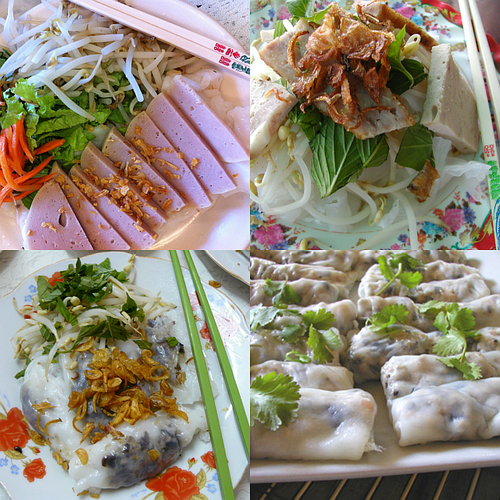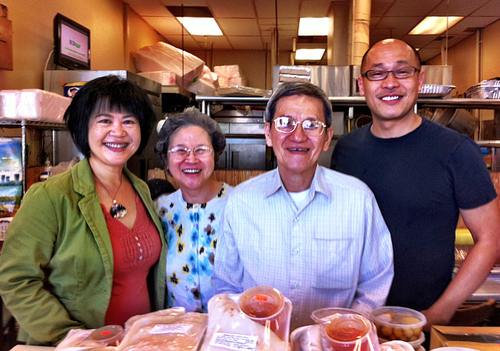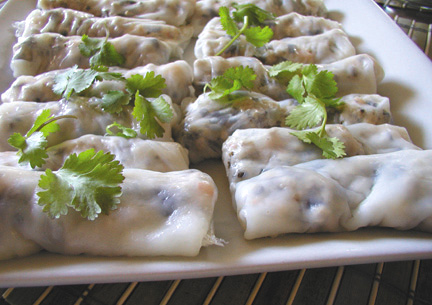
On my last day in Seattle, Eric Banh took me and my friend, vegetarian
cookbook author Michael Natkin out to eat. We started at noon and I ended up
eating 4 meals with Eric that day. (Then I flew to Portland and had a very late dinner with other friends.)
Eric is the chef and restaurateur behind the Monsoon restaurants and Ba Bar; he also owned Baguette Box up until a little while ago when he sold it. He and his sister, Sophie, operate modern Viet restaurants that are fun and sophisticated tributes to Vietnam’s food traditions. We met in 2005 when I dined at Monsoon after it had been favorably reviewed in Gourmet. Eric and I clicked while talking about elevating the status of Vietnamese food. We’ve been friends ever since. Every time one of my book releases, he and Sophie organize a special event at one of their restaurants to showcase my work.
We hang out and eat a lot when I’m in town. Right now, Eric is obsessed about freshly made bun round rice noodles and banh cuon steamed rice noodle rolls. For more info on bun check the bun primer post but what are banh cuon? They are thin rice sheets that can be stuffed with a meat and mushroom mixture (like bottom row in the photo above) or served unstuffed (top row in the photo) with slices of silky Viet sausage (goi or cha lua), nuoc cham dipping sauce, and sometimes bean sprouts and herbs (if you’re southern Vietnamese). If you've had fun noodles or think of banh pho noodles, banh cuon are thinner and not cut into noodles.
Though the noodles are more expensive, Eric and Sophie offer it at Monsoon at a fair price to customers. On the weekends at Ba Bar, Mr. Chau mans a banh cuon station by the front door, chatting with customers as he steams and fills their orders.
Eric is advocating for stellar bun rice noodles and banh cuon steamed rice noodles rolls so that his customers can further appreciate Vietnamese cuisine. He wanted to show me what Seattle had to offer.
When we set out on our afternoon food adventure, Eric took us to his local bun noodle supplier: Van Loi Noodle Company. There we met proprietors Auntie Xung and Uncle Trung, an older couple that’s been producing Vietnamese rice products and running a deli of sorts on Rainer for about 15 years.
We were too late to see the bun being made so Auntie Xung walked us through how she made steamed rice noodle rolls (banh cuon). I’d never seen industrial equipment before for making banh cuon. In Saigon, I’d visited a neighborhood banh cuon maker who ground her rice in a blender and set up her equipment in back kitchen. There was no operation like what I saw at Van Loi.
Here it is, captured in a slideshow-cum-video:
Did you notice these things in the video?
- Stone grinder – Modern technology for an old world method. That thing was the size of a small refrigerator.
- Nearly flat ladle - Auntie Xung uses the ladle to efficiently spread the batter out onto the fabric.
- Long bamboo stick – Every old school Viet cook probably has a pair of super long bamboo sticks for cooking. My dad made a set for me to fluff rice. They sell them in Vietnam at the markets. The one used here is extra long and thin, perfect for getting
under the rice sheet (about 18 inches wide) and lifting it off. - Towel covered rod – This was sensational. The makeshift tool helps to transport the rice sheet to the tray. I think the towel was just a regular industrial dishtowel. Not much lint.
What did Auntie Xung sprinkle on the rice sheet? Fried shallots. The ones that she served us on the plate didn’t have them. The rolls were tender and delicious. What did I say at the end? Very pretty, that's all.
When I asked the couple about their business, Auntie Xung immediately said that they were tired! It’s a 7 day operation that starts around 4am and ends around 6 or 7pm. They have to be there all the time. “We’re getting old,” she said.
Eric revealed that they’d asked him to take over the shop but he demurred. His restaurants were enough for him and his sister. “Fresh Viet rice noodles are delectable, a tradition that needs to be supported,” Eric remarked.
Amen. If people are willing to pay for fresh ramen and Italian pasta, why not bun, banh pho, and banh cuon? Auntie Xung and Uncle Trung produce an endangered food. When they retire, it is hard to know who will take up the mantle at Van Loi; their kids have careers that don’t require as much time or energy. I imagine that their story resonates in other Vietnamese communities.
Banh Cuon Pointers
If you’re interested in exploring banh cuon, these tips may help:
How to make banh cuon? There’s a home version in Into the Vietnamese Kitchen on page 270 that uses rice flour and a nonstick skillet. It’s about 85% as good as the steamed kind. Here’s a slightly larger photo of the one in the collage at the top:
The steamed version can be done at home but rigging up the steamer and such is a major time commitment. [UPDATE: In 2023, I have a new and easy method in my book, Ever-Green Vietnamese. A bonus video tip is on this page.]
Where to buy banh cuon?
While you can buy them on styrofoam trays at Viet markets, they are freshest at places called “lo banh cuon”. Google it and see what you get. Also, they are sold at places that make bun rice noodles. Those shops are called “lo bun.” The term “lo” means kiln or oven in Vietnamese so a “lo banh mi” is bread
bakery. There’s a certain industrial quality about it, though many places do sell other kinds of food too, functioning like a deli or cafe. For example, Van Loi sells banh mi, fried cha gio imperial rolls, dumplings and other Viet snacks.
How to find banh cuon joints?
They are typically named “Banh Cuon xxx” and located in Viet enclaves. Btw, banh cuon Thanh Tri is named for a famous spot in northern Vietnam that’s known for gossamer thin rice sheets. To see the various options, check out the menu at the chain of Banh Cuon Tay Ho. You can buy takeaway fresh banh cuon from these places too. If you have a favorite banh cuon spot, share it below!
Related links:



















Linda @ My Foodgasm Journal says
Awesome! I enjoy having Vietnamese food, but never learned/ explore the making of it, so this is very entertaining.
Andrea Nguyen says
Thanks, Linda!
Sandy says
I can't view the video right now, but the making of banh cuon reminds me of a Martha Stewart when she had someone making them on her show years ago. Martha said, "It's really very easy!" which I think she says for just about anything. Of course it was easy for Martha - someone else was doing the work!
calily says
The nonstick pan method is how we do it around our house. I do love those fresh banh cuons from the steamers though. YUM.
Love the write-up on the mom and pop shop!
Andrea Nguyen says
LOL! So true. Everything is easy for Martha. She has a staff. Wouldn't that be great for the rest of us?
Andrea Nguyen says
Thanks Calily. I love banging the nonstick pan to get the banh cuon out. Great way to start the day or get your aggression out. 😉
calily says
I will know not to cross you! haha. Do you put potato starch in your batter as well?
Nate @ House of Annie says
This reminds me of the old school way they make mee sua noodles in Sarikei here in Sarawak:
http://www.houseofannie.com/making-hand-pulled-mee-sua-in-sarikei/
Truly an endangered art.
Andrea Nguyen says
Awesome post, Nate! Thanks for the link.
Twan says
Wow, I hope someone will take over this work when this couple is too old and tired to continue. It certainly is a labor intense work. But it's an art in itself. What a beautiful job, and thank you for showing us how it is being done.
Jason says
So, Andrea, when ican we expect your book on Asian Noodles being published?
Dao says
Hi! banh cuon is my favorite Vietnamese dish!:) great to see this video! love it, Thanks! For daily life i cheat and do a twisted version with banh trang that I can savour in 30'..it's not banh cuon but it does fulfill sudden crave..:) cheers, Dao
Dao says
Ps : this is the link to my twisted recipe 🙂
http://carnetdesaveursetsenteurs.com/2013/03/15/226/